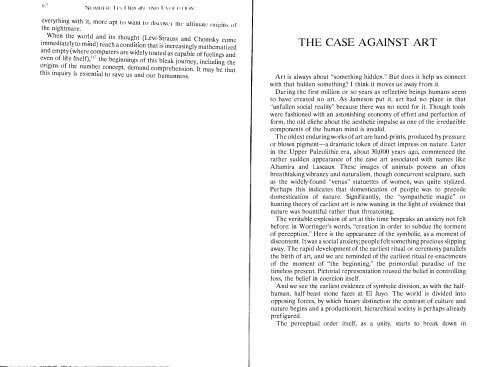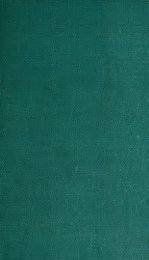CONTENTS - ouroboros ponderosa
CONTENTS - ouroboros ponderosa
CONTENTS - ouroboros ponderosa
You also want an ePaper? Increase the reach of your titles
YUMPU automatically turns print PDFs into web optimized ePapers that Google loves.
Nt IMllj · l.'.: 11'\ ( )II( dN .. \NI) 1'-\ ( 1j [I[ If 1N<br />
everyhing with it, more apt to want to discover till' ultilllate origin.') ()r<br />
the nightmare.<br />
. When the world and its thought (Levi-Strauss and Chomsky come<br />
Immediately to mrnd) reach a condltlOn that is increasingly mathematizcd<br />
and empty (where cmputers are widely touted as capable of feelings and<br />
even of Irfe Itself),ll. the beginnings of this bleak journey, including the<br />
ongl . ns of the number concept, demand comprehension. It may be that<br />
this mqulry IS essential to save us and our humanness.<br />
THE CASE AGAINST ART<br />
Art is always about "something hidden." But docs it help us connect<br />
with that hidden something" I think it moves us away from it.<br />
During the first million or so years as reflective beings humans seem<br />
to have created no art. As Jameson put it, art had no place in that<br />
"unfallen social reality" because there was no need for it. Though tools<br />
were fashioned with an astonishing economy of effort and perfection of<br />
form, the old cliche about thc aesthetic impulse as one of the irreducible<br />
components of the human mind is invalid.<br />
The oldest enduring works of art are hand-prints, produced by pressure<br />
or blown pigment-a dramatic token of direct impress on nature. Later<br />
in the Upper Paleolithic era, about 30,000 years ago, commenced the<br />
rather sudden appearance of the cave art associated with names like<br />
Altamira and Laseaux. These images of animals possess an often<br />
breathtaking vibrancy and naturalism, though concurrent sculpture, such<br />
as the widely-found "venus" statuettes of women, was quite stylized.<br />
Perhaps this indicates that domestication of people was to precede<br />
domestication of nature. Significantly, the "sympathetic magic" or<br />
hunting theory of carliest art is now waning in the light of evidence that<br />
nature was bountiful rather than threatening.<br />
The veritable explosion of art at this time bespeaks an anxicty not fcIt<br />
before: in Worringer's words, "creation in order to subdue the torment<br />
of perception." Here is the appearance of the symbolic, as a moment of<br />
discontent. It was a social anxiety; people felt something precious slipping<br />
away. The rapid development of the earliest ritual or ceremony parallels<br />
the birth of art, and we arc reminded of the earliest ritual re-enactments<br />
of the moment of "the beginning," the primordial paradise of the<br />
timeless present. Pictorial representation roused the belief in controlling<br />
loss, the belief in coercion itself.<br />
And we see the earliest evidence of symholic division, as with the halfhuman,<br />
half-beast stone faces at El Juyo. The world is divided into<br />
opposing forces, by which binal)' distinction the contrast of culture and<br />
nature begins and a productionist, hierarchical society is perhaps already<br />
prefigured.<br />
The perceptual order itself, as a unity, starts to hreak down in






